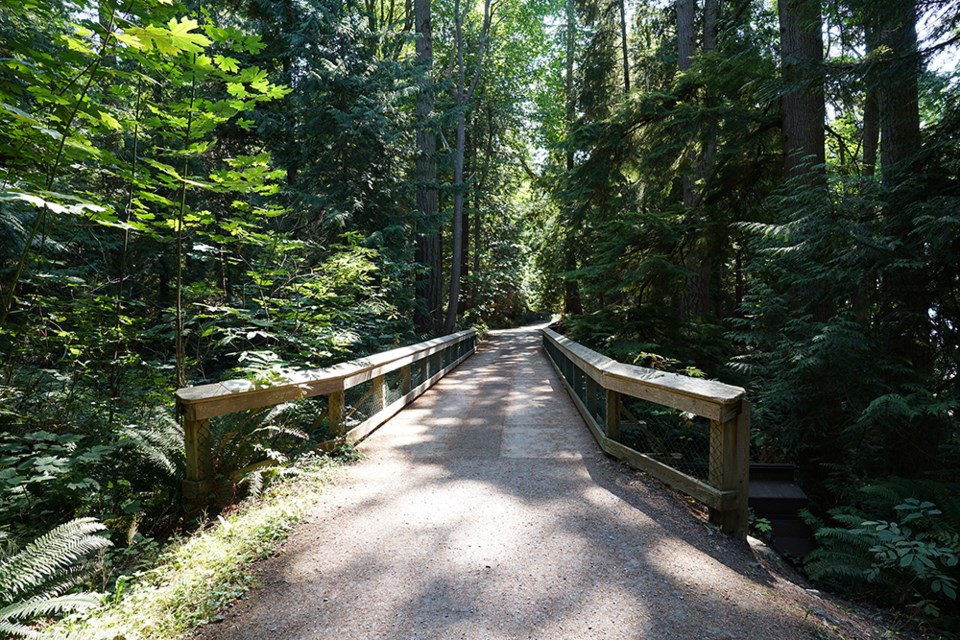City of Powell River’s Willingdon Beach trail has reopened.
After a nine-month closure so linear work could be performed for the new consolidated wastewater treatment plant, barriers and signs have been taken down and people can once again traverse the trail, which has been upgraded.
City parks supervisor Mike Kaban said the work done was a very collaborative effort.
“The majority of the project leadership is done through our engineering department,” said Kaban. “[Engineering technologist] Mik Drosdovech worked closely with Graham Infrastructure, the construction company, and the parks department, through myself, was involved with the fine details on whether we should line the path and what materials we use. I looked after securing wood fibre.
“The wood fibre we used beside the trail that Graham put down adjacent to the pathway was ground up at the airport tree clearing job, so we didn’t have to pay for it. That will turn to compost and allow us to plant wildflowers and whatnot next to the beach trail, so that is my intention.”
Kaban said Graham did the work on the trail and worked with him on exactly how he wanted the trail to be configured.
“They did a great job,” added Kaban. “The path material we chose is a really nice, tight surface that will hopefully keep us pothole free for years to come. It will be smoother.”
Kaban said in future, the city will be working on further connectivity of paths between Westview and Townsite. He said the revitalized bike trail is bicycle friendly, but there also needs to be awareness with multi-users on the path.
“The trail is not a designated bike lane so we do ask for respect between all the different users, respecting each other’s boundaries,” added Kaban.
He said dog walking along the trail is encouraged, but within the boundaries of the city, there is no dog off-leash space with the exception of the dog parks [Townsite and Westview].
“The trail is definitely not an off-leash area,” added Kaban.
Dog owners are also reminded to pick up after their dogs. There are bags for excrement located near the trailhead.
Kaban said the trail is going to be a great asset for the city. He said it originated as railway grade from the old logging camp at Michigan Landing to the mill site, so that’s why it is so flat and wide.
Final product
Drosdovech said the final product turned out to be a lot better than people would have expected. For the trail bed, a specific crushed rock was used to finish the trail, he added.
“The contractor laid it down, graded it and compacted it nicely, so the trail should be accessible to pretty much all users,” said Drosdovech. “It should be wheelchair accessible.”
Drosdovech said great care was taken during construction of the wastewater treatment plant’s piping and that archaeological monitoring played an important part.
“There’s some very sensitive archaeological sites along the Willingdon Beach Trail and close to the Willingdon Beach campsite,” said Drosdovech. “We had to take our time to ensure we weren’t disturbing anything, and if archaeological artifacts were located, work stopped, they were properly catalogued, and the appropriate archaeological investigations took place before we proceeded.”
Drosdovech said there were some coniferous trees along the alignment that had been identified in a survey before work on the trail was conducted.
“We took a lot of care to ensure when construction went past, that damage didn’t occur to the root systems, and when materials were put back, they were put back in a manner that would ensure the longevity of those trees,” added Drosdovech. “There had been ground-penetrating radar surveys done, as well as a number of other tree surveys to identify anything that was sensitive.
“There’s going to be a little less vegetation where we did some clearing, but within a year or two of growing seasons, you won’t notice that we were in there. Best management practices were employed on the project. We’re proud of the result and we hope everyone can get out and enjoy it.”



